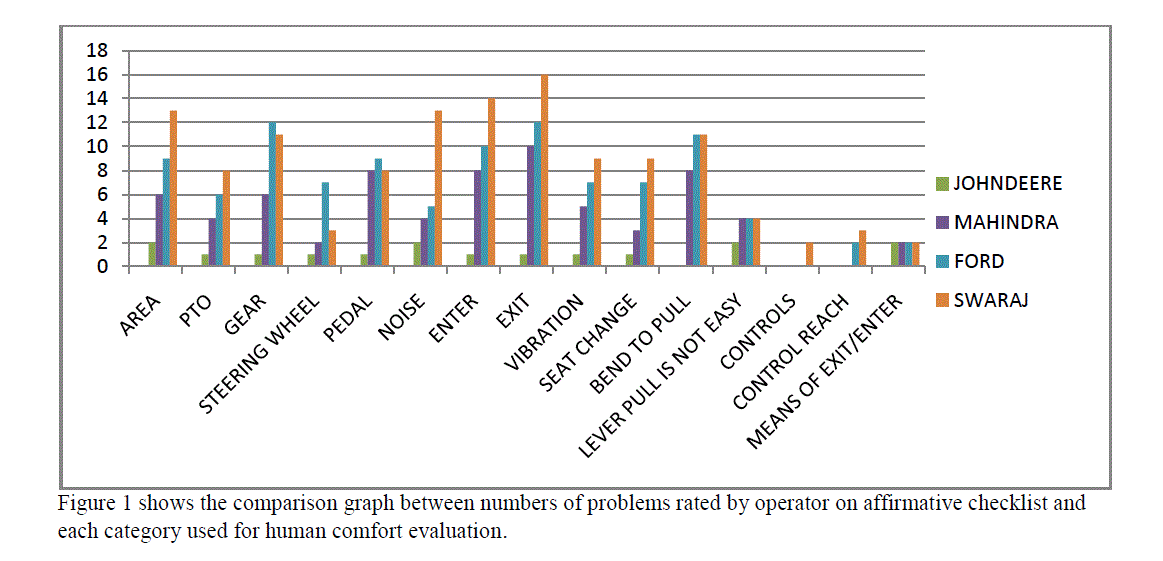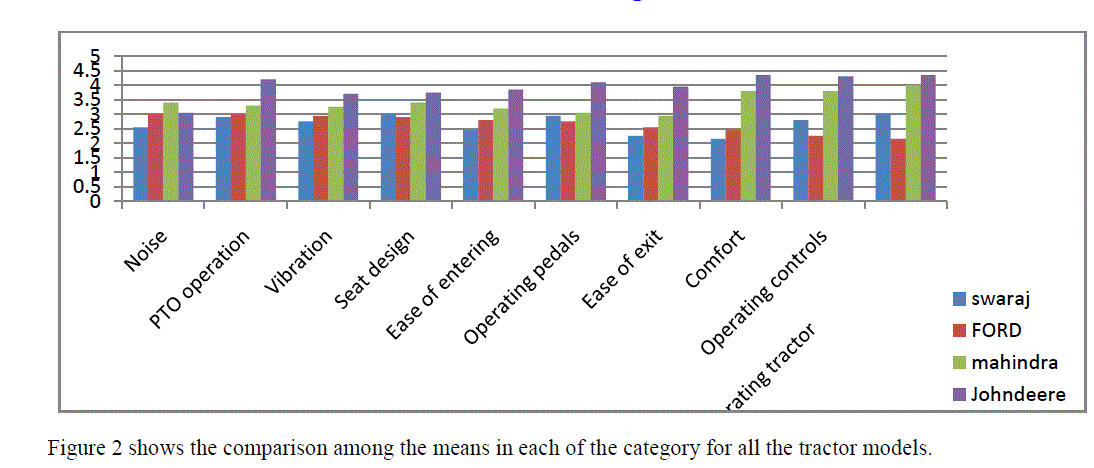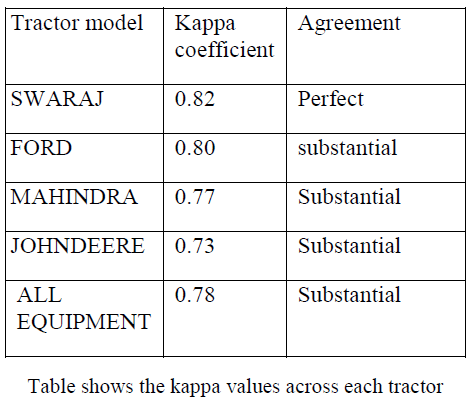ISSN ONLINE(2319-8753)PRINT(2347-6710)
ISSN ONLINE(2319-8753)PRINT(2347-6710)
Viveksheel Rajput1, Parveen Kalra2, Jaswinder Singh3
|
| Related article at Pubmed, Scholar Google |
Visit for more related articles at International Journal of Innovative Research in Science, Engineering and Technology
The productivity of operators and their performance are mainly depends upon the workspace in which he intends to work. This can be achieved only when they are comfortable in their workplaces designed for their best performance. Poorly designed tractors force operator to attain awkward posture which leads to musculoskeletal (MSDs) discomfort thereby reducing their efficiency and productivity. In order to eliminate discomfort study was conducted to evaluate tractor comfort from operator’s perspective and identifying poorly designed areas. Human comfort in tractors can be evaluated by direct involvement of the operators. In this study twenty operators were used to complete a questionnaire followed by an interview to get the detailed feedback of the tractor design. Objective of the thesis is (a) to evaluate tractor design for comfort (b) to identify poorly designed areas that need improvement (c) comparison of four tractor models (swaraj 855, ford 3630, Mahindra 555 and johndeere 5310) (d) to assess the repeatability of tractor design checklist. This study assessed the repeatability of a checklist designed to evaluate tractor design aspects that affect human discomfort. A series of task operations was performed by the operators on all the tractors sharing similar features. Operator’s opinion on the ease of entering, ease of exiting, PTO operations, operating pedals, operating tractors and overall comfort were collected on likert scale which is further used for evaluation analysis. Results showed that there are areas which need improvements in different design aspects in all tractors based on operator’s recommendations. Johndeere was rated as more comfortable among all the tractors. Repeatability assessment result shows that agreement in terms of kappa coefficients ranged from 0.61 to 1.0 (substantial-to-perfect reproducibility) across each tractor, and an overall kappa coefficient of 0.787 (substantial reproducibility) when considering all tractor together. The strength of kappa suggested that checklist is capable of identify areas that need improvement irrespective of the tractor model and observer used for evaluation.
Keywords |
| Tractors, Ergonomic evaluation, Comfort, Safety |
INTRODUCTION |
| It has been stated by marras and karwowski 2006 [1] that ergonomic approach is used in human centered design of automobiles in order to ensure safety to the users. Ergonomic is the science of designing the job to fit the operator rather than forcing the operator’s body to the job. Focus of ergonomics is to improve the interface between man and machine, thereby improving their productivity and efficiency. It has confirmed by Gibson et al 2006 [2] in various studies that operators are more productive at their work when they are working in the environment designed for the best human performance. Human performance can be achieved when they are comfortable in their workplaces and ensuring comfort to the humans is the main objective of the study. Hertzberg 1972 [3] stated that comfort is best defined as the absence of discomfort. Ride comfort is generally used to describe the degree of human comfort offered by moving vehicle. The international standard of ISO-2631[4] defines the ways to assess the ride comfort in an objective manner by evaluating vibration and gives the definition of ride comfort index. Helander 2003 [5] described the difference between comfort and discomfort, saying that comfort is primarily a perception, while discomfort is a secondary measure. Maximizing human comfort will increase tractor operator’s satisfaction in the tractor, as well as their safety and productivity. Driessen et al., 2008 [6] and Looze et al., 2003 [7] mentioned that comfort is a subjective construct and needs to be evaluated by the users while using the products. This study focuses on the automotive ergonomics which aims to optimise the space in which operators has to fit and make them comfortable while driving as mentioned by Roe, R.W. 1993 [8]. In vehicle design, the term human factor is interchangeably called as automotive ergonomics as given by Adreoni, G et al, 2003 [9]. |
| During the task execution of tractors, operators have to attain different awkward postures which may lead to work related musculoskeletal disorders. Dupuis, H., and G. Zerlett: et al 1987 [10] stated that static sitting and whole body vibration are the two most common musculoskeletal disorders reported among the operators when they are exposed to awkward posture for long term. When parts of the body are near the extremes of their range of movements, stretching and compression of tendons occur as stated by Andersen, 2003 [11] which further leads to MSDs. Minimizing human discomfort by identify poorly designed areas of ergonomics is our main objective. For this purpose agriculture tractor evaluation study has conducted and discussed in this paper. |
AGRICULTURE TRACTOR EVALUATION |
| Tractor is a machine which is used for off road usage and designed to supply power to the attached implements as given in SAE, 2003 [12]. The present study is based on checklist evaluation method which was designed to identify poorly designed areas effecting human performance. Design of check list and its repeatability assessment was based on the case study conducted by Kittusamy, 2003[13] which developed a checklist to evaluate cab design of mobile construction company for identifying characteristics that are affecting the operator performance. Study objective is to evaluate the Indian drivers for comfort while operating agriculture tractor in the fields with the assessment of checklist repeatability which was done to check the agreement between the responses made in two surveys using Kappa statistics given by Cohen 1960 [14]. Underlines are the objectives of the study: |
| a) Identify areas which are not designed properly from ergonomic perspective and needs further improvement. This will modify tractor characteristics that can enhance the overall operator safety and health. |
| b) Recommendations to each tractor for improvement in design using operator’s opinions. |
| c) Comparison of tractors using checklist score obtained from the operators. Tractor models compared in this study are Swaraj, Ford, Mahindra and Johndeere. |
| d) The repeatability of the checklist from the responses of the operators was evaluated using Kappa statistics. it calculates the agreement between two surveys and thus ensuring the strength of checklist repeatability used for tractor design evaluation. |
TASKS AND PROCEDURE |
| The pilot study was conducted in the fields of muktsar village where operators were asked to perform set of tasks. During this scenario they had to accomplish the following tasks: starting the tractor and driving it on the field, operating lifts, operating clutch, pedals, PTO (power take off) and stopping the engine. Tractor of four different types were assessed during the study .Operators were asked to repeat the task on each tractor model separately. Operators were asked to maintain constant speed of the tractor in order to ensure consistency in test. To assess the repeatability check of questionnaire, the same study was conducted in the fields of Amritsar village where operators were asked to perform the same task but operators used were different. Measures of agreement between numbers of responses in both the study were assessed in order to have a reliability check on checklist. |
| A. Subjects |
| The study consisted of 20 male tractor operators for pilot study required to complete the tasks and to give responses to the questionnaire. Their mean age is 36.55 years ranging from 25 years to 63 years and mean experience is 14.13 years. For repeatability assessment, 20 male operators were used with mean age of 35.5 years ranging from 27 years to 55 years and mean experience of operating tractors is 12.8 years. All the operators are familiar with tractor operations and they were briefed about the study objective. |
| B. Tractor Model |
| Four different tractor models manufactured by different companies sharing similar features was used in this study to evaluate operator’s satisfaction with the environment and to identify problems. Models used for this research study are Swaraj 855(2007), ford 3630(2003), Mahindra 555(2007) and Johndeere 5310(2009); all these tractors are of same horsepower (HP) that is 55. |
DATA COLLECTION AND EVALUATION |
| After the completion of task participants was asked to answer the questionnaire, their detailed information was noted i.e. their name, education, experience and occupation. Questionnaire consisted of 58 close ended questions which grouped into categories on 5 point likert scale (1 highly disagree; 2 disagree; 3 neutral; 4 agree; 5 highly agree). Categories which need operator’s perspective are ease of operating the tractor assessing the seat, ease of entering and exiting the tractor, vibration, noise, ease of operating controls, pedals, overall comfort and ease of operating the PTO. Once each participant completed the questionnaire, an interview was conducted for them. Data gathered was reviewed before doing further evaluations. |
RESULTS |
| From the survey results and participant responses it has concluded that Swaraj has generated more number of problems as comparative to other tractor models. It has the lowest affirmative responses on the checklist. Number of problems responded by each operator in each tractor in particular category is given below for all the tractor models (Swaraj, Ford, Mahindra and Johndeere) with their graphical representations. Checklist inferences provide knowledge of areas that are poorly designed and needs improvement. Tractor model with number of problems reported in each of the category is shown in figure 1. |
RECOMMENDATIONS |
A. Swaraj Recommendations |
| From the mean results it has emerged that categories affecting the operators were those related to ease of enter/exit and overall comfort as they were received the low score as seen from the figure 2. Participants identified that tractor area is not large enough thus creating problem for entering and exiting the tractor, thus it is recommended to look look upon the sitting workspace area of the tractor. More than sixty percent of the participants revealed that “middle gears was one of the problem for enter/exit problem” and also results indicated that the ease of locating and operating controls have highlighted the importance of control layout in the tractor but most of the participants suggested to have side levers instead of middle ones. Most of the operators reported problem on the ease of PTO operations and suggested that “it should be easy if separate clutch is there for PTO operations”. Operators demanded for adjustable armrests. From the human comfort perspective, operators had negatively reported the interaction with the Swaraj design elements. Areas which need further improvement and to be looked upon for better design are Enter/Exit, PTO, Noise, Space, Gear transmission. |
 |
B. Ford Recommendations |
| Operators had negatively reported that Gear transmission is not easy and should be made smoother in order to have more comfort. It is recommended that gear lever should be shifted to side as sixty percent of the operators demanded side levers and suggested that “enter/exit would be easier if side gears are there”. More than fifty percent of the operators feel that they had to bend to pull the levers; so need is there to look upon the design aspect of the levers and their locations. This tractor model does not have seat horizontal adjustment and need to have this type of adjustment as almost every operator suggested to have seat adjustment. Operators demanded for the separate clutch for the PTO operation, adjustable armrests. Areas of improvement in Ford are that of space, Gear transmission, side levers and enter/exit problem. |
C. Mahindra Recommendations |
| Ease of operating tractor gets the highest score as seen from the figure for this tractor which suggested that interface of operators with this category have positively impact on the design of the tractor. But problems related to that of enter /exit and pedal operations as approximate fifty percent of the operators found it difficult to operate. As gear levers are situated in the middle, some operators rated it as a problem for getting out of the tractor as it gets the lowest score. It is recommended to have side levers and smoother pedal operations from operator’s point of view. |
D. Johndeere Recommendations |
| Johndeere interface with the categories was found satisfactory. Gear levers are situated on the side which makes operator getting in and out of the tractor easier and also gear operation is smoother with respect to others. Problem rated by operators in this model is that of noise and vibration which needs to be improved from operator’s perspective. |
 |
E. Common Recommendations |
| In spite of individual recommendations there are some common recommendations which were suggested to be implemented by more than sixty percent of the operators as they find it necessary for human comfort. These are: |
| Steering wheel adjustability |
| Digital controls |
| Cabin |
| Backward seat adjustment for lumbar |
| Adjustable Armrests |
| Levers to be placed on right side |
| Footsteps should be there on the right side of the tractors for entering and exiting. |
RESULTS |
| Kappa coefficient was used to check the repeatability of checklist designed for evaluating the human comfort while interacting with the design elements of the tractor. Calculated value of Kappa coefficient is shown in table and ranged from 0.6 to 1.0 across each piece of the tractor models which represents moderate to perfect agreement showing good repeatability of checklist. |
| Swaraj has resulted with highest kappa value showing that it has good repeatability for the design checklist as problems rated by operators in first survey have good agreement with the problems rated by operator in the second survey. These results validate the use of checklist for evaluating areas that was poorly designed from the human perceptions. Ford and Mahindra shows similar results on the basis of kappa value representing perfect and substantial agreement between two surveys. Johndeere has also substantial agreement but its value is lowest in the table which means agreement between same classifications is not as high as in other cases. When considering all the tractor models together, kappa coefficient is 0.78 which indicates substantial repeatability for the tractor design checklist. |
 |
CONCLUSIONS |
| This study was conducted to evaluate the tractor design elements, whether it was ergonomically designed or not, which are important from the operator perception of comfort. Checklist evaluation method with its repeatability assessment was used for this purpose. It was concluded that perception of comfort in tractor is influenced mainly by enter/exit of the tractor. Problems related to the ease of enter/exit from the tractor was reported high among all the operators which suggested that levers should be shifted to the side at higher level. This would help them to get in and out of the tractor in an easier way. Furthermore, controls should be easy to use and should be smoother in operation from the current designs. It was concluded that noise is one of the aspect to be look upon as it was rated as disturbing while working on the fields because it enables the operator from hearing. With regard to noise level, Swaraj was rated highly noiser among tractors. Some common recommendations had already made by evaluating operator responses, as it was concluded that there should be prevention from flies, dust and noise if there is a provision of cabin. Furthermore, it was reported that there must be a provision for steering wheel adjustability and seat backward adjustment as a comfort factor, which further helpful on the ease of sitting posture on the seat while reducing musculoskeletal disorders. Also, sixty percent of the operators preferred digital controls over mechanical controls as it is easier to understand and operate. These modifications could be easily made to positively affect the operator’s comfort. Result showed that Johndeere has preferred over other tractor on the ease of operating and overall comfort. It was found that tractor design checklist contains excellent repeatability when used among all the tractors and its use can provide information that can be used by operator and engineers to eliminate the poorly designed areas which further improve the health and safety of the operator. Checklist repeatability confirmed that a set of questions on checklist were capable of identifies design features which need improvement. It assured that different tractor models can be evaluated by this checklist independent of the type of observers and individuals used for evaluation. This method for evaluating tractor comfort is easy to use and low cost investigation method over other analysis methods. |
FUTURE SCOPE OF THE STUDY |
| As the present study was conducted in order to evaluate the comfort level of the operator that interacts with the tractor while working on the fields. All the operations that were performed in this study were off road operations. On road assessment should be considered as a future work evaluation study for the human comfort so that more areas of modifications would be generated. One another factor to be considered for future study is the response differences between youngsters and experts who had more experience in the field of operating the tractors. There significant differences should be considered in the study to have more sophisticated results. |
References |
|